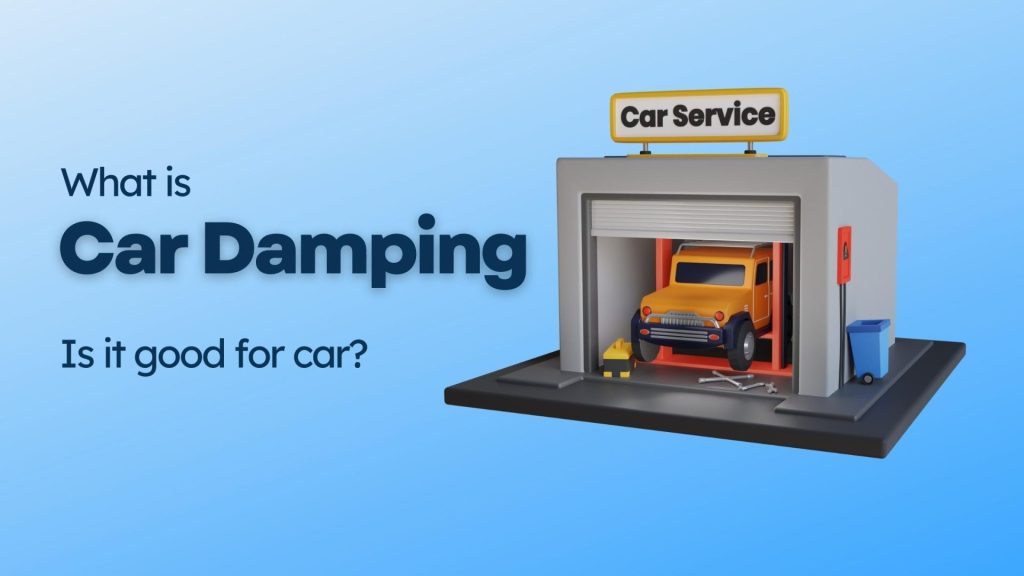If you’re looking for What is damping in cars or the Car damping benefits or Car damping cost and related to car door damping or its LSI query then you are in the best place.
What is damping in cars?
Damping in the audio car means putting sheets on the doors and panels of your vehicle to lessen the vibrations and improve the volume and the punch. Simply put, it’s placing a sheet of vinyl on the panel of your doors.
What area of the vehicle needs to be slowed down (Dumped)?
At a minimum, the doors need to be dilated. The most enthusiastic drivers are known to put damping to the entire vehicle. The car is stripped to its metal, and the damping sheet is then glued to the metal. Then, the plastic panels of the car will be reassembled.
The floor, roof doors, all doors, boot, boot/dicky door bonnet/hood must be dilutable for the greatest effect.
What are the different kinds of doors damping?
There are three kinds of door-damping options available
1. Single damping.
2. Double damping.
3. Triple damping.
One Damping The Damping Sheet is put on the interior part of the shell that forms the door’s exterior.
Double Damping Damping sheets are placed on the inside, forming the outer layer of the doors and exterior panel facing metal.
Put triple Damping Damping sheet on the inner side on the outer side of the shell, as well as the outside panel of the inside-facing door metal, as well as on the inside side of the door panel.
Car damping benefits
Here are some Car damping benefits.
1. The door closes with a bang.
2. The door feels more heavy and strong.
3. The bass and punch are louder and crisper.
4. Improves audio quality.
5. Reduces the sound of the door.
6. The cabin is a little quieter.
Let’s explore them.
Reduced Noise Transmission or Background sound:
The most commonly used places for sound deadening are the floor, the doors, and the fenders of vehicles. Inside a door, we add a damping layer on the exterior of the door’s skin.
The material adds weight to the metal and reduces its ability to transfer sound energy to the car’s interior.
Another place to install sound damping is the interior doors’ metal skin. The skin seals the big gaps in the door and stops sound from behind the speaker from canceling out a sound coming from the front. Results in dramatically enhanced mid-bass and bass performance.
Fewer Rattles and Less Vibration:
Focal BAM for the majority of the installations we have. The sound-deadening material is a thick insulating layer of foam that is placed on the outside of the.
The foam stops wire harnesses, plastic panels, door release mechanisms, and door latches as well, as the power lock rods rattling and buzzing while driving down the road.
How can I buy damping sheets?
1. Determine the area where you’d like to get damp.
2. Select a sheet with a high butyl content. You should buy the ones that are produced in India. They are made in the US, and Europe has lower Butyl content due to cooler climates. It is not a good fit for the conditions of hot tropical heat in India, particularly those in Tamil Nadu.
3. Find out the size of the sheet, thickness sheet, and price. Do not just ask for the price.
4. Ask the shopkeeper for the total sheets required to be damp and meet the total price.
Do you consider damping to be a requirement?
It’s only required when you are looking for a highly professional setup or a high-end setup. If you’re a lover of music, then damping is the best option for you.
If you’re ready to endure the speakers’ jarring resonance and are not interested in damping, skip it. But damping is strongly advised if you’re thinking of upgrading your speakers or adding an amplifier and subwoofer.
Should we use rollers instead?
You Can use the roller tool to spread the sheet evenly, and pressing it down with a roller provides a good grip. The best part is that it gives a great grip, but the downside is the removal process is difficult.
If the roller isn’t installed, we aren’t sure of a strong adhesion bond to the panel. In the end, I would recommend damping the installation using a roller.
Can damping be accomplished by yourself?
Absolutely. It isn’t at all difficult. All we need is patience and some time. All you require is a “minus” screwdriver (Rs. 50/(-) to remove the trim and a roller tool (Rs. 500/-).
Tools require for car dumping
1. The Star Screw Driver is medium size.
2. Flat screwdriver.
3. Clean hands.
4. Piece of chalk
5. Yoga mats as required.
6. Themocol as required.
7. Polyester bushes.
8. Paintbrush.
9. Fevicol.
Some points to remember door damping
1. It takes about 30 minutes for a single damping door, 45 minutes for double damping, and one hour for three damping doors.
2. The boot takes about an hour. The Hood & Tailgate takes 30 minutes each.
3. The entire car can take 8 hours to complete, which includes stripping and re-fitting, assuming that one person is working.
4. If you’ve had an accident, You may need to apply damping sheets again.
5. Re-use of the same type of sheets is challenging. The manufacturer is constantly updating the sheets, just like mobile phones.
6. There is a risk of odor and leakage if the sheet isn’t high-quality.
7. Get the total amount of sheets required, the total area covered, and the price before purchase. Most dealers offer that they will charge Rs./-xxx per sheet and add sheets as they proceed. It is not true as you don’t have the budget for the higher amount.
8. Ensure the installer applies the roller tool.
9. Enquire about labor costs. Between 300 and 400 dollars per door and boot, and around 1000-1500 for floor and roof.
10. Check that the price of the sheet includes tax.
Brands that make car door damping sheet
Here are some top Brands of cars Damping Sheets:
Zing Technologies and Asiatic and TUSITA and Festnight and Robostore India and NVX

Now Complete Guide on car door damping?
Let’s Understand the door vibration and noise problem. We will discuss the complete guidebook in 13 easy steps or which are the important things you should need to know.
Doors are constructed of fewer gauge metals, with a high natural frequency. In comparison to 40-300 Hz ( between 40 and 200 vibrations per second ), The audio frequencies we use are the 20hz-20000 Hz
The bass frequencies range from 1 200 Hz up to 200 Hz. The doors tend to vibrate vigorously because the vibrations aren’t solely due to sound generated by speakers but also the sound produced. Say, if the speakers are placed in the boot, not inside doors, only sound waves cause the vibrations.
But for indoor mount speakers, there are two kinds of vibrations,
1)70 % vibrations due to the speaker.
2.) Only 30% of vibrations are caused by sound.
Now let’s start
1. Open the door, then scroll through the entire window. Switch off the car and take the key off.
2. In the front door, you must remove two screws and one rivet ( plastic). First, take off the screw on the cup holder.
3. Remove the screw from beneath the lever that opens the door, then Remove the rivets made of plastic (here is the most difficult part)
The center circle will move inside.
4. Then, using a flat-head screwdriver, turn the rivets out through the gaps in the outer circle and Keep safe the rivets and screws ( opt for a small plastic box).
5. Start from the bottom to the top. Finally, you had to lift your door pad vertically to unhook it from the door sleeve.
6. Then, using one hand, hold the panel, then take then the screwdriver with the stars, and push the sleeve to lock the connector.
7. Pull out the connector. Now the door is unlocked, put the pad on a smooth surface, and repeat this process on all doors.
8. Turn on the music system, connect your phone to the aux, choose an upbeat song, and then set an equalizer.
9. Then turn the bass of your head device to 6(max volume) and keep the volume up so you can hear the vibrations from the door.
10. With a screwdriver, put the point of it on the door’s metal surface and feel the vibrations wherever you feel the most vibrations. Draw the circle(if you feel more vibrations, then draw a circle). Will draw the circle).
Make sure to do this for any door.
11. Use a piece of paper to cut out the necessary sizes for gluing yoga mats onto and cut by where you traced circles. Stick it with fevicol applying the brush to yoga mats. Please put it in place, and leave it to dry for five hours.
12. put thermal in between the gap between the speaker’s magnets and the door’s outer edge. It will provide stiffness to speakers and help reduce the amount of vibration.
13. Install the panel now and then take it off. You will see chalk traces on the door’s yoga mats and door panels.
Important Things you need to keep in mind before door damping:
1. DO not PULL OUTWARDS because a wire is connected to the window switch.
2. Apply a thick layer of glue for a better bond.
3. The wrong DIY is not satisfied with it since they purchase costly damp mats and then plug the holes in the sheet metal. It is not enough to close the doors or make them more secure.
4. Some people place the pads on the plastic door covers. The speaker is mounted to the metal, not on these covers. Metal only vibrates and hits the plastic, causing it to sound.
5. Certain install speakers using wooden spacers, which are of no use. Wood efficiently transfers energy to the door. There were only three screws that transferred energy prior.
Car damping cost
The car damping cost range in India starts from 250 rupees/piece. If we talk more in-depth details then you can visit here: link
FAQ
Do you think damping is good for your car?
Simply saying, dampening will surely make your car’s cabin quiet. It can greatly reduce background noise so you can hear every note in your favorite music. Additionally, rattle and vibration are also slowed inside a vehicle that is dampened.
How many sheets are needed to dampen the vehicle?
Small cars require at least two sheets per door, while an SUV might require 2.5-3 sheets to cover a door. It’s about 1000/sheet or 8k for the bulk package (9 sheets). Small cars require at least 2 sheets per door, and an SUV may require 2.5-3 sheets per entrance.
Why is damping needed?
Damping can be a method to minimize vibrations. It is vital to safeguard the system that it is used. It is the case with springs in drawers and doors where damping stops blows during opening and closing, keeping the springs and ensuring they are protected.
For more car-related queries:
How to tune a car with a laptop? (5 easy process)
How to charge laptop in car?(5 simple methods)
